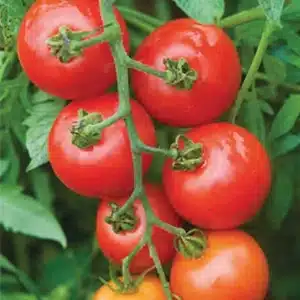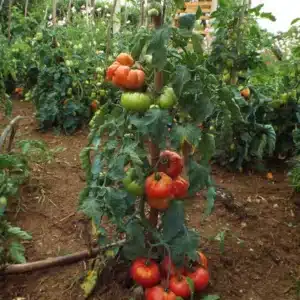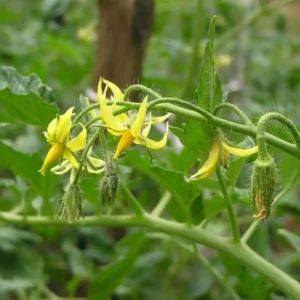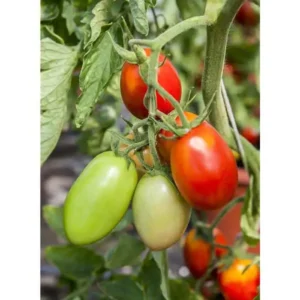Tomato




Plant Description:
Highly prized for their wonderful flavor and nutritional value, tomatoes are the most widely cultivated vegetable in America today. The tomato is actually the edible fruit of ‘Solanum lycopersicum,’ the botanical name of the plant, which translates from Latin to the phrase, “tomato” species of the Nightshade family.” Home-grown, vine-ripened tomatoes are tastier and more delicious than those available from grocery stores. A few garden plants can produce plenty of colorful tomato fruits to be enjoyed fresh in salads or cooked into sauces throughout the summer. Tomatoes, which are available in colors ranging from deep burgundy, bright red, yellow, green, or orange, can also be canned, frozen, pickled, pureed, or sun-dried to provide taste and nutrition all year long. Nutritionally, tomatoes contain high levels of the powerful antioxidants, Lycopene, and Vitamin C, both of which provide many health benefits. Differing in traits such as fruit size, color, and flavor, there are tomato varieties available to thrive in any sunny area with at least three months of warm, frost-free temperatures. Typically grown as annuals within USDA hardiness zones 2A-10B, tomato plants are highly-sensitive to frost and prefer temperatures ranging consistently within 55 to 95 degrees Fahrenheit. Extreme temperatures outside of this range are likely to affect the plant’s ability to set fruit. Tomato plants typically reach a mature height of six to nine feet, but are available in dwarf sizes, as well, making ideal plants for patio containers or small edible gardens. Tomatoes bloom with tiny yellow flowers which develop into fruit and ripen on the vine throughout the summer and early fall. Native to South and Central America, the tomato was introduced to Europe by the Spanish as early as the 16th century. “Tomate,” the Spanish word for tomato,” was derived from the Nahuatl term, “tomatl.” Because tomatoes are a member of the poisonous Nightshade plant family, they have only become widely popular since the 20th century when it became known that the fruits were actually edible and delicious. However, the leaves, roots, and stems do, indeed, contain toxic alkaloids, and should never be consumed in large quantities. Today, tomatoes are cultivated world-wide in a wide array of varieties, fruit sizes, shapes, flavors, and colors to appeal to every taste.
Tomato plants thrive in well-drained, fertile loam with a pH of 6.1 to 6.5. Ideally, several inches of organic matter should be mixed into the top several inches of soil before planting. The plants require six to eight hours of direct sunlight daily. It is important to select a tomato variety that has been proven to perform well in the area where it is to be planted. Potted plants purchased from a reputable local nursery should be buried all the way to the top few leaves in order to develop stronger roots along the stems. Tomatoes love warmth and won’t begin to thrive until both the soil and air temperatures remain consistently warm, preferring temperatures ranging from 55 to 95 degrees Fahrenheit. When planting tomatoes, one must choose between two different growth habits, determinate and indeterminate. Determinate tomato varieties, such as bush tomatoes, produce large harvests of fruit within several weeks, reach a certain height, and then cease to grow and produce. Indeterminate varieties continue to grow and produce tomato fruit throughout the growing season, potentially reaching a height of ten or fifteen feet. Seed can be purchased commercially or removed from a ripe tomato, soaked for fourteen hours in warm water, dried, and planted into the garden within seven days. Seed can be started indoors in flats and germinated on a heat mat six to eight weeks before the last spring frost or directly sown into the garden several weeks after the last frost, when the soil has warmed to at least 50 degrees Fahrenheit. Seed should be barely covered with 1/4 inch of soil and kept evenly moist. Tomato seeds take six to eleven days to germinate. New plants should be spaced at least three to four feet apart.
Tomatoes do not like extreme heat or cold and will produce the most fruit in temperatures falling between 50 to 95 degrees Fahrenheit. Tomatoes have extensive root systems and need to be watered deeply and frequently, perhaps even daily in the heat of summer. Plants need at least one inch of water per week. The surrounding soil must drain well and remain evenly moist. A thick layer of mulch helps conserve moisture and keep out weeds. Tomatoes require a support, such as a trellis, stake, or cage to prevent pest damage and fungal disease.
Tomatoes grow best in a slightly acidic, well-drained loamy soil. Plants should be fertilized at the time of planting and monthly thereafter throughout the growing season with an organic fertilizer especially for tomatoes. A balanced, organic 10-10-10 or 2-3-1 slow-release fertilizer, can be used, making sure to carefully follow the directions on the product label. Too much nitrogen can result in leaf growth but lessen the production of fruit.
Indeterminate tomatoes should be pruned by carefully pinching tips of main stems in early summer so that the plant’s energy is directed toward flowering. Suckers that develop between two branches can also be removed to direct energy toward fruit production. The bottom leaves close to the ground should be removed to prevent fungal disease, especially if beginning to yellow. Determinate tomato plants do not require pruning, and to do so may lessen fruiting potential.
It is very important to select tomato varieties resistant to verticillium and fusarium wilt. Tomato hornworms can be dusted with bacillus thuringiensis, which is commercially available at most reputable nurseries and is non-toxic to humans.









